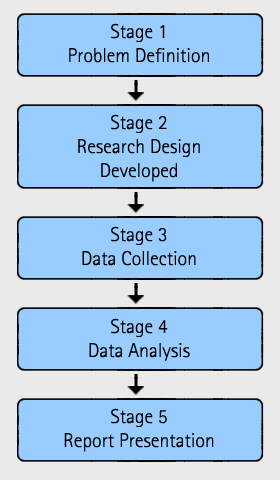| The marketing research process outlines six broad
stages. A researcher must ensure that great care is invested in
each of these phases in order to reduce the risk of errors. For
example, if you were to erroneously identify a problem then no
matter how well you collected data, the overall conclusions of
your work would be flawed.
The marketing research process
| Figure 6.1 The marketing
research process |
|

| (Adapted from: Malhotra, N.K. and Birks, D.F.
(2003) Marketing Research: An Applied Approach,
UK: Pearson Education) |
|
|
|
| |
|
Problem definition
In this first stage the researcher has to identify the problem
that needs to be investigated. At this stage a close inspection
of the environment is necessary in order to formulate a research
problem that is relevant. The 'formal' problem identification
is a broad statement of the general problem and identification
of the specific components of the marketing research problem.
Defining a marketing research problem can be difficult. A novice
researcher could easily interpret symptoms or causes as a problem.
Unlike symptoms and causes, a research problem lays the foundations
of what needs to be investigated. For example, a new player in
the leisure industry could be experiencing a slump in sales (symptoms)
and notice changes in consumer needs (causes). A suitable research
definition could go along the lines of:
What are consumers in the young family segment's expectations
of an all-inclusive holiday? (for an example of an all-inclusive
holiday package, visit: Travelbase).
Research design formulation
The research design is the blueprint of a marketing research project.
By providing a detailed account of how the research problem is
to be addressed, the research design sets down the foundations
of an investigation.
Because of its strategic role, the research design considers
what research methods are best for collecting data and which are
most suitable for analysing the data collected. The choice of
methods will depend on how suitable a method is for addressing
the problem set and the research strategy a research subscribes
to. There are two broad types of research:
- quantitative;
- qualitative.
Quantitative research is interested in quantifying and statistically
analysing the responses of a representative sample of respondents.
Alternatively, qualitative research questions a small number of
respondents and provides insight and in-depth observations.
A researcher has a vast array of methods to choose from. Generally,
marketing researchers use survey methods, focus groups and depth
interviews as their primary means of collecting data. Surveys
use questionnaires to interview a large number of people (see
Example of Questionnaire) [ link to questionnaire example]. Alternatively
focus groups are small group discussions organised and moderated
by a trained individual. Depth-interviews are one-to-one sessions
between one respondent and an interviewer in which issues can
be probed in greater detail.
At Marwell Zoo, the survey method has become a reliable vehicle
to gain marketing insight:
 |
| Heather
Moore, Marketing and Promotions Officer
Marwell Zoo, Hampshire |
|
 |
The data collection stage involves collecting the data required.
If you were interested in penetrating the themed holiday and hotel
market you would think of looking at all sources of information
available (for examples for themed holidays visit travel-browsing.co.uk).
Before embarking on primary research, you would probably check
existing secondary sources in order to become familiarised with
the basic characteristics of this market. You might discover that
some of the information you need has already been collected.
From government sources like the UK National Census to research
made available by independent marketing research companies ( for
example, www.mintel.co.uk; www.euromonitor.com)
there are numerous sources available.
Primary research on the other hand is research that is specifically
designed to address the problem identified. For instance if you
wanted to understand what consumers' expectations of themed holidays
were, you could survey a number of respondents at an airport.
Bournemouth Borough Council conducts a similar activity.
 |
| Jon
Weaver, Marketing Manager, Bournemouth
Borough Council |
|
 |
Data analysis
A researcher will also have to decide what method of analysis
will be used to make sense of the data. Generally, statistical
software packages will be used to analyse quantitative (for example
SPSS) data,
while qualitative data will be organised in a matrix in order
to observe emerging trends.
Report presentation
The final stage of the marketing research process involves transcribing,
coding, organising, interpreting and verifying the data collected.
The final report should clearly state the research problem and
outline research objectives. It must also describe how research
was conducted, specifying who was asked and how, as well as the
methods used to analyse the data.
In addition, the marketing research report presents and evaluates
the main findings of the investigation and includes conclusion
and recommendations sections. KMPG's report on
E-commerce in transport, leisure and tourism industries is a good
example of a marketing research report.
|

